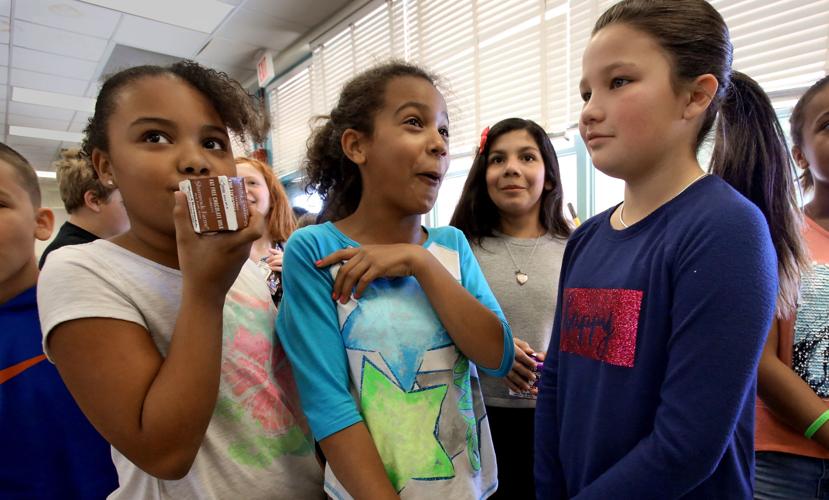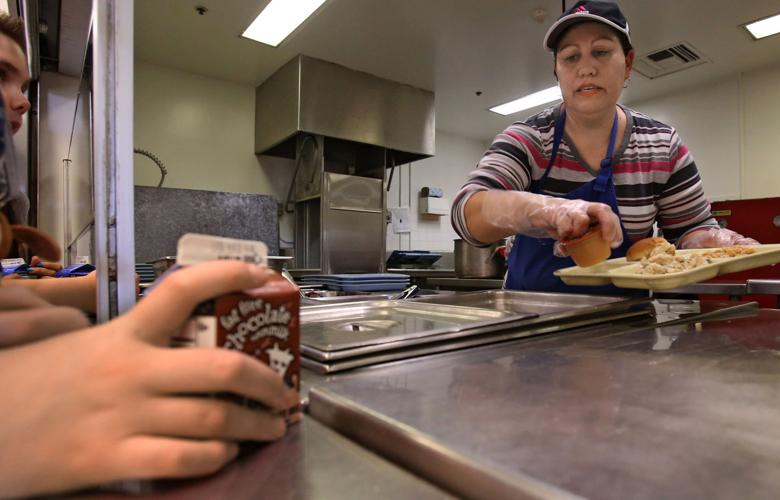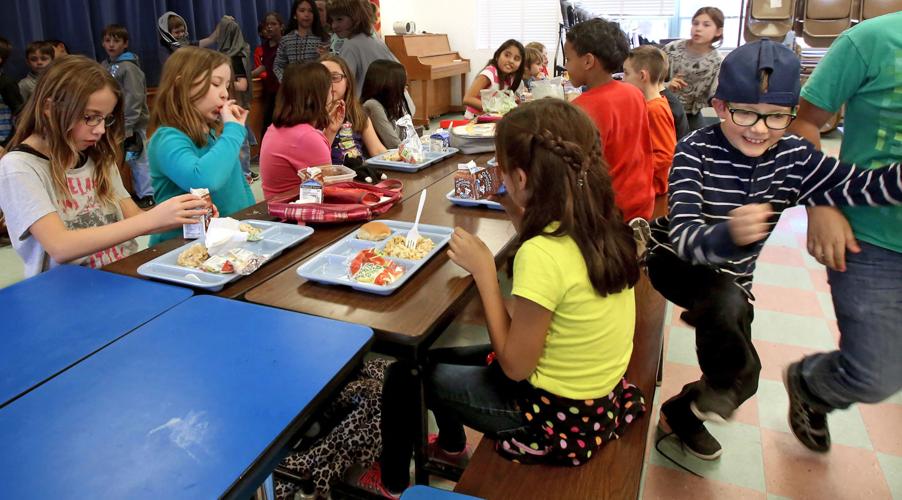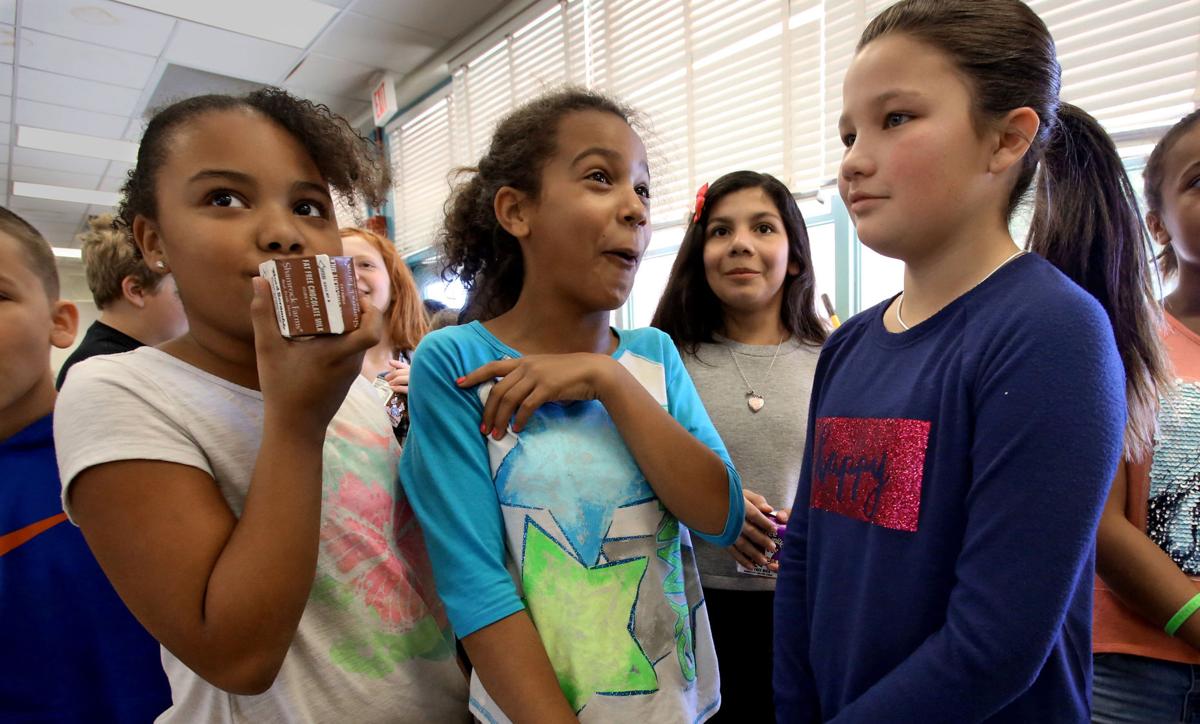Hangry math is never good.
Neither is food waste or playground drama.
With the hope of alleviating some of those problems, many schools across Tucson have implemented "recess before lunch" or "reverse lunch" in which students hit the playground before sitting down to eat in the cafeteria.
Kellond Elementary, a TUSD school on the east side, started the practice the first Friday after winter break, joining a handful of other schools in the district.
Why
The idea is that kids are more hungry after playing, so they'll eat more of their food — which means less waste — and will go to class calm and ready to learn. It also takes the rush to get to the playground away — another way to reduce food waste.
As a kindergarten student, Melissa Haun's son (who is now in 4th grade) went to Borton Elementary, which had recess before lunch.
He moved to Kellond after earning a full time spot in the GATE program for first grade.
"I noticed that he was quick to get frustrated immediately after school and it was because he was HANGRY," said Melissa Haun, mother and photographer. "He would eat very little of his lunch so he and his friends could go outside to play."
Haun did some research online and found a lot of positives behind it. For example, the kids were eating more food and drinking more milk.
"This was stated as especially important for schools with a high percentage of free or reduced lunch, since it may be the best nutrient packed meal of some children's day," Haun said. "There was less food waste. The kids settled back into the classroom atmosphere quicker if recess is first, and as I saw in his kinder year, my son didn't come home hangry."
The concept is not brand new. It gained traction in 2002 when four Montana schools launched a pilot program, funded with a USDA Team Nutrition grant. During the pilot, they measured plate waste and feedback from students, school staff and food service staff.
The results were recorded in a 2008 research survey done by the Montana Office of Public Instruction. It found that common benefits were improved classroom behavior, increased lunch consumption and decreased food waste, among other things.
The most common challenges faced were revising the schedule, hand washing and staffing/supervision.
By 2013, 31 percent — or 275 — of Montana schools had implemented recess before lunch.
More info on the research can be found here.
Haun first presented the information she found to Kellond's site council in 2014. After a couple years of researching, which included visiting Tucson schools that had already implemented Recess Before Lunch and lots of teacher and PTO feedback, it was a go.

As they arrive from recess, fourth grade students begin standing in line in the cafeteria at Kellond Elementary.
How it works
Kellond's lunch break is the same amount of time as it was before — 35 minutes — but it's structured so they go to the playground for 15 minutes and the cafeteria for 20.
Each grade is released at separate times to go play for 15 minutes. Then they line up with their class to go to the cafeteria for lunch. While in line, a monitor walks down the line with hand sanitizer so the kids can clean their hands.
Students are released to go in the cafeteria by class. They have 20 minutes to get their lunch and eat.
"We have kids who will eat in 30 seconds and throw it away just to go outside, but now its like 'no this is eating time.' This is all you have to do for the next 15 minutes," said Holly Leman Hammel, elementary and K-8 director for TUSD.
If a student is still eating when their teacher is there to get them, he or she will tell the student they have a few more minutes while the teacher gets the rest of the class together and picks up some of the mess.
"We want children to eat, obviously," said Brenda Meneguin, principal of Kellond. "It's important that they get this time."

Single-handedly, cafeteria worker Maria Arvizu hurries to give students their choice of chicken, broccoli, pasta or bread and an apple sauce at Kellond Elementary.
How it's going
Aside from a few kinks in getting the lines to go smoothly outside of the cafeteria, Meneguin says it's going well. And the school is getting the results it hoped to see.
"Less food gets thrown away because they're hungry after playing outside," Meneguin said. "And some of our kindergarteners have reported they have less tummy aches from running around on full stomachs."
Getting that nutrition is important, since school lunch is the most important meal for some students, since they don't get much else at home, Meneguin said.
"So we have students coming in and eating instead of dumping half of their food because they want to go play," Meneguin said. "This is the time they get to eat. We are still having a couple kinks getting them lined up, but it is more important they're getting the time to eat because then they're having more productive afternoons."

Fourth grade students sit and enjoy their lunch even as classmate Liam Clark, 9, gets up to squeeze more fun into his time away from class at Kellond Elementary.
The school has also seen a reduction in playground incidents and an increase in teaching time inside the classroom.
"We're in the third week..What we're finding so far is we're having less issues with behavior from the playground," Meneguin said.
Before the switch, teachers had to use valuable teaching time to help solve many of the playground incidents. So, as part of the lunch changes, the school put a desk outside of the counselor's office stocked with forms for kids to fill out, saying what the problem was and how they tried to solve it if they feel it still needs resolving. Students give the form to their teacher.
The teacher will then find a few minutes in class to address the students involved individually or if the teacher feels it needs more attention, she or he can send them to speak to the counselor or principal.
"What would happen is, as we were trying to get the kids in line after the monitors blew the whistle, kids were coming up to us saying 'so and so did this and so and so did that,' whereas if they're having recess before lunch they've calmed down a little bit afterwards and maybe got a chance to talk to the person about it," said Geri Spears, 4th grade teacher. "What we're hoping is to empower the kids to problem solve a little bit more and if they haven't solved it, we have an avenue of bringing it to the teacher's attention...For my kids, it really empowers them to be able to do that."
Teachers have noticed that students are more calm and ready to work immediately instead of needing cool down time.
"Before you got kids that were sweaty and exhausted and now I have kids that are awake," said Sara Martinez who teaches a fourth and fifth grade class.
Martinez teaches math right after the lunch hour, so having the students awake and ready to learn is the biggest benefit to her. Plus, she says most of them eat more of their lunches now, so they come back less cranky.
"Hangry math is never good," Martinez said.

Fifth grade students from Kellond Elementary have their lunch break after recess Jan. 31, 2017.
Schools in other local districts are doing this too
In the Vail school district, five elementary schools have implemented the practice, as well as a few schools in the Marana district.
Results at Kellond mirror those seen at Senita Valley Elementary in the Vail school district when it switched to recess before lunch five years ago.
"The teachers absolutely love it and would never want to go back," said Connie Erickson, the school's principal. "They feel that by eating after they play it helps them concentrate better and the kids are not hungry when they come back because they ate all their lunch."
As the school principal, Erickson likes that she can chat with the kids while they're in the cafeteria without feeling like they're trying to rush out the door to go play. She also said she's noticed a difference in the noise level in the cafeteria since they have already had that time to run around and talk to their friends.
"When they come in they seem more relaxed," Erickson said.
Kids and parents weigh in on recess before lunch
Amy Rodriguez's two kids attended Marshall Elementary another TUSD school that was doing recess before lunch. She said they had enough time to eat and they ate more of their lunch after recess than they did before recess.
Haun, one of the parents who got the ball rolling on this at Kellond, is happy it's finally happening. And says her son is excited about it, too.
When Rogers Elementary was still open, kids played first. Heather Scavo's children went there before attending Kellond and eventually moving out of the district.
"I'm all for it," Scavo, mother of four said. "The kids get all that pent up energy out, they were calm at lunch, they had time to eat because they weren't racing to get outside for recess, they actually ate their lunch, they were relaxed after lunch and ready to learn."
Two of Carmelita Kirberger's children attend Desert Willow Elementary, another Vail school that does recess before lunch and she really likes it.
"I feel that my kids eat better and are not as rushed to go out and play," Kirberger said. "I believe that they are getting their energy out and time with their friends and are ready to eat when it's time. They are also allowed to take what food they don't finish, in the time allowed, back into class to finish."
Spears has heard from students who feel like they have less time to eat, but it's how they perceive it, she says.
"Some kids are perceiving they're not getting enough time to eat," Spears said. "I think a couple minutes can be taken off of that time lining up, but I also think they're used to going into the cafeteria and taking as much time as they want...You have the same amount of time. It's how you use that time."

Fourth graders and best friends Eileen Richards, 10 and Evelyn Bentley, 9, sit together during their lunch break at Kellond Elementary. Reverse lunch, or lunch after recess, is new at Kellond but has already been implemented in a number of schools within TUSD.
Nicholaus White, a nine-year-old fourth-grader, feels like he has more time to eat now because he used to be in such a rush to go outside, he would only take a few bites and leave the cafeteria. Then after playing for so long, he didn't feel like being in class.
"But, now you have more brain energy and get better grades. It's awesome," Nicholaus said. "You have more time to eat and wind down from playing."
Kylie Mate, an 11-year-old fifth grader says she didn't like how she'd go back to class tired and sweaty before, and that with the changes, she has more energy to learn since she's had time to wind down in the cafeteria after playing.










